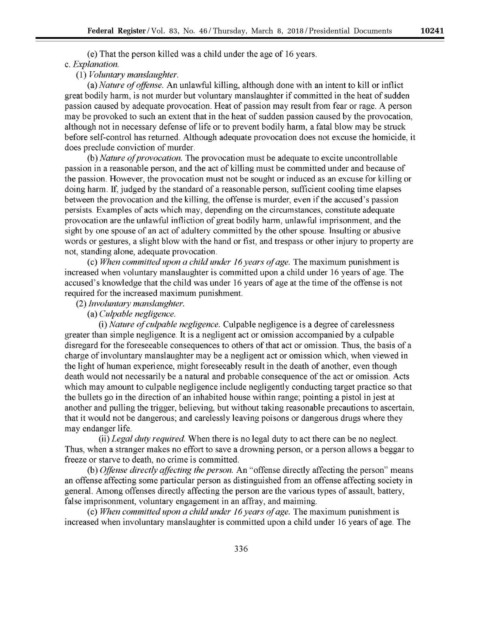Page 538 - Trump Executive Orders 2017-2021
P. 538
Federal Register / Vol. 83, No. 46 / Thursday, March 8, 2018 / Presidential Documents 10241
(e) That the person killed was a child under the age of 16 years.
c. Explanation.
(1) ·voluntmy manslaughter.
(a) Nature of offense. An unlawful killing, although done with an intent to kill or inflict
great bodily harm, is not murder but voluntary manslaughter if committed in the heat of sudden
passion caused by adequate provocation. Heat of passion may result from fear or rage. A person
may be provoked to such an extent that in the heat of sudden passion caused by the provocation,
although not in necessary defense of life or to prevent bodily harm, a fatal blow may be struck
before self-control has returned. Although adequate provocation does not excuse the homicide, it
does preclude conviction of murder.
(b) Nature of provocation. The provocation must be adequate to excite uncontrollable
passion in a reasonable person, and the act of killing must be committed under and because of
the passion. However, the provocation must not be sought or induced as an excuse for killing or
doing harm. If, judged by the standard of a reasonable person, sufficient cooling time elapses
between the provocation and the killing, the offense is murder, even if the accused's passion
persists. Examples of acts which may, depending on the circumstances, constitute adequate
provocation are the unlawful infliction of great bodily harm, unlawful imprisonment, and the
sight by one spouse of an act of adultery committed by the other spouse. Insulting or abusive
words or gestures, a slight blow with the hand or fist, and trespass or other injury to property are
not, standing alone, adequate provocation.
(c) 71Vhen committed upon a child under 16 years (if age. The maximum punishment is
increased when voluntary manslaughter is committed upon a child under 16 years of age. The
accused's knowledge that the child was under 16 years of age at the time of the offense is not
required for the increased maximum punishment.
(2) involuntary manslaughter.
(a) Culpable negligence.
(i) Nature of culpable negligence. Culpable negligence is a degree of carelessness
greater than simple negligence. It is a negligent act or omission accompanied by a culpable
disregard for the foreseeable consequences to others of that act or omission. Thus, the basis of a
charge of involuntary manslaughter may be a negligent act or omission which, when viewed in
the light of human experience, might foreseeably result in the death of another, even though
death would not necessarily be a natural and probable consequence of the act or omission. Acts
which may amount to culpable negligence include negligently conducting target practice so that
the bullets go in the direction of an inhabited house within range; pointing a pistol in jest at
another and pulling the trigger, believing, but without taking reasonable precautions to ascertain,
that it would not be dangerous; and carelessly leaving poisons or dangerous drugs where they
may endanger life.
(ii) Legal duty required. When there is no legal duty to act there can be no neglect.
Thus, when a stranger makes no effort to save a drowning person, or a person allows a beggar to
freeze or starve to death, no crime is committed.
(b) Offense directly affecting the person. An "offense directly affecting the person" means
an offense affecting some particular person as distinguished from an offense affecting society in
general. Among offenses directly affecting the person are the various types of assault, battery,
false imprisonment, voluntary engagement in an affray, and maiming.
(c) "ffl"hen committed upon a child under 16 years~~ age. The maximum punishment is
sradovich on DSK3GMQ082PROD with PRES DOCS VerDate Sep<11>2014 18:39 Mar 07, 2018 Jkt 244001 PO 00000 Frm 00355 Fmt 4705 Sfmt 4790 E:\FR\FM\08MRE0.SGM 08MRE0 ER08MR18.357</GPH>
increased when involuntary manslaughter is committed upon a child under 16 years of age. The
336

